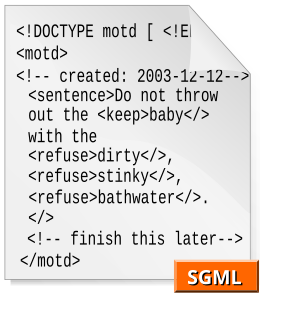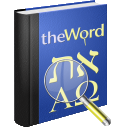
Hypertext Markup Language (HTML) is the standard markup language for documents designed to be displayed in a web browser. It can be assisted by technologies such as Cascading Style Sheets (CSS) and scripting languages such as JavaScript.

In computer text processing, a markup language is a system for annotating a document in a way that is syntactically distinguishable from the text, meaning when the document is processed for display, the markup language is not shown, and is only used to format the text. The idea and terminology evolved from the "marking up" of paper manuscripts, which is traditionally written with a red or blue pencil on authors' manuscripts. Such "markup" typically includes both content corrections, and also typographic instructions, such as to make a heading larger or boldface.

The Standard Generalized Markup Language is a standard for defining generalized markup languages for documents. ISO 8879 Annex A.1 states that generalized markup is "based on two postulates":
Extensible Markup Language (XML) is a markup language that defines a set of rules for encoding documents in a format that is both human-readable and machine-readable. The World Wide Web Consortium's XML 1.0 Specification of 1998 and several other related specifications—all of them free open standards—define XML.
XSLT is a language for transforming XML documents into other XML documents, or other formats such as HTML for web pages, plain text or XSL Formatting Objects, which may subsequently be converted to other formats, such as PDF, PostScript and PNG. XSLT 1.0 is widely supported in modern web browsers.

In computing, Xerces is Apache's collection of software libraries for parsing, validating, serializing and manipulating XML. The library implements a number of standard APIs for XML parsing, including DOM, SAX and SAX2. The implementation is available in the Java, C++ and Perl programming languages.
XSD, a recommendation of the World Wide Web Consortium (W3C), specifies how to formally describe the elements in an Extensible Markup Language (XML) document. It can be used by programmers to verify each piece of item content in a document. They can check if it adheres to the description of the element it is placed in.
In computing, RELAX NG is a schema language for XML—a RELAX NG schema specifies a pattern for the structure and content of an XML document. A RELAX NG schema is itself an XML document but RELAX NG also offers a popular compact, non-XML syntax. Compared to other XML schema languages RELAX NG is considered relatively simple.
An XML schema is a description of a type of XML document, typically expressed in terms of constraints on the structure and content of documents of that type, above and beyond the basic syntactical constraints imposed by XML itself. These constraints are generally expressed using some combination of grammatical rules governing the order of elements, Boolean predicates that the content must satisfy, data types governing the content of elements and attributes, and more specialized rules such as uniqueness and referential integrity constraints.

The Exhaustive Concordance of the Bible, generally known as Strong's Concordance, is a Bible concordance, an index of every word in the King James Version (KJV), constructed under the direction of James Strong. Strong first published his Concordance in 1890, while professor of exegetical theology at Drew Theological Seminary.
Speech Synthesis Markup Language (SSML) is an XML-based markup language for speech synthesis applications. It is a recommendation of the W3C's voice browser working group. SSML is often embedded in VoiceXML scripts to drive interactive telephony systems. However, it also may be used alone, such as for creating audio books. For desktop applications, other markup languages are popular, including Apple's embedded speech commands, and Microsoft's SAPI Text to speech (TTS) markup, also an XML language. It is also used to produce sounds via Azure Cognitive Services' Text to Speech API or when writing third-party skills for Google Assistant or Amazon Alexa.
Open Scripture Information Standard (OSIS) is an XML application, that defines tags for marking up Bibles, theological commentaries, and other related literature.
The Theological Markup Language (ThML) is a "royalty-free" XML-based format created in 1998 by the Christian Classics Ethereal Library (CCEL) to create electronic theological texts. Other formats such as STEP and Logos Library System (LLS) were found unacceptable by CCEL as they are proprietary, prompting the creation of the new language. The ThML format borrowed elements from a somewhat similar format, the Text Encoding Initiative (TEI).

Go Bible is a free Bible viewer application for Java mobile phones. It was developed by Jolon Faichney in Surf City, Gold Coast, Queensland, Australia, with help from several other people who assisted in making versions for other languages and translations. Go Bible is installed like any other midlet by copying the .jar and .jad file to the cell phone by USB or Bluetooth. The English KJV Go Bible 1.1 can also be installed using WAP download.
Biblical software or Bible software is a group of computer applications designed to read, study and in some cases discuss biblical texts and concepts. Biblical software programs are similar to e-book readers in that they include digitally formatted books, may be used to display a wide variety of inspirational books and Bibles, and can be used on portable computers. However, biblical software is geared more toward word and phrase searches, accessing study bible notes and commentaries, referencing various modern translations, cross-referencing similar passages and topics, biblical dictionaries, original language texts and language tools, maps, charts, and other e-books deemed relevant to understanding texts from a philological approach.
eXtensible HyperText Markup Language (XHTML) is part of the family of XML markup languages. It mirrors or extends versions of the widely used HyperText Markup Language (HTML), the language in which Web pages are formulated.

theWord is a free Bible study software application for Microsoft Windows. It was first released in 2003 and developed by Costas Stergiou. It offers Bibles, commentaries, dictionaries, general books, maps, search capabilities, and support for Bibles in several languages.
XQuery is a query and functional programming language that queries and transforms collections of structured and unstructured data, usually in the form of XML, text and with vendor-specific extensions for other data formats. The language is developed by the XML Query working group of the W3C. The work is closely coordinated with the development of XSLT by the XSL Working Group; the two groups share responsibility for XPath, which is a subset of XQuery.
The Almeida Recebida is a Portuguese Bible version based on the Received Text manuscripts, as opposed to the Westcott and Hort revisions. The 1848 version of the Almeida Bible was also based on the Received Text, but its language was old. The language of the Almeida Recebida is updated to a more recent Portuguese.






